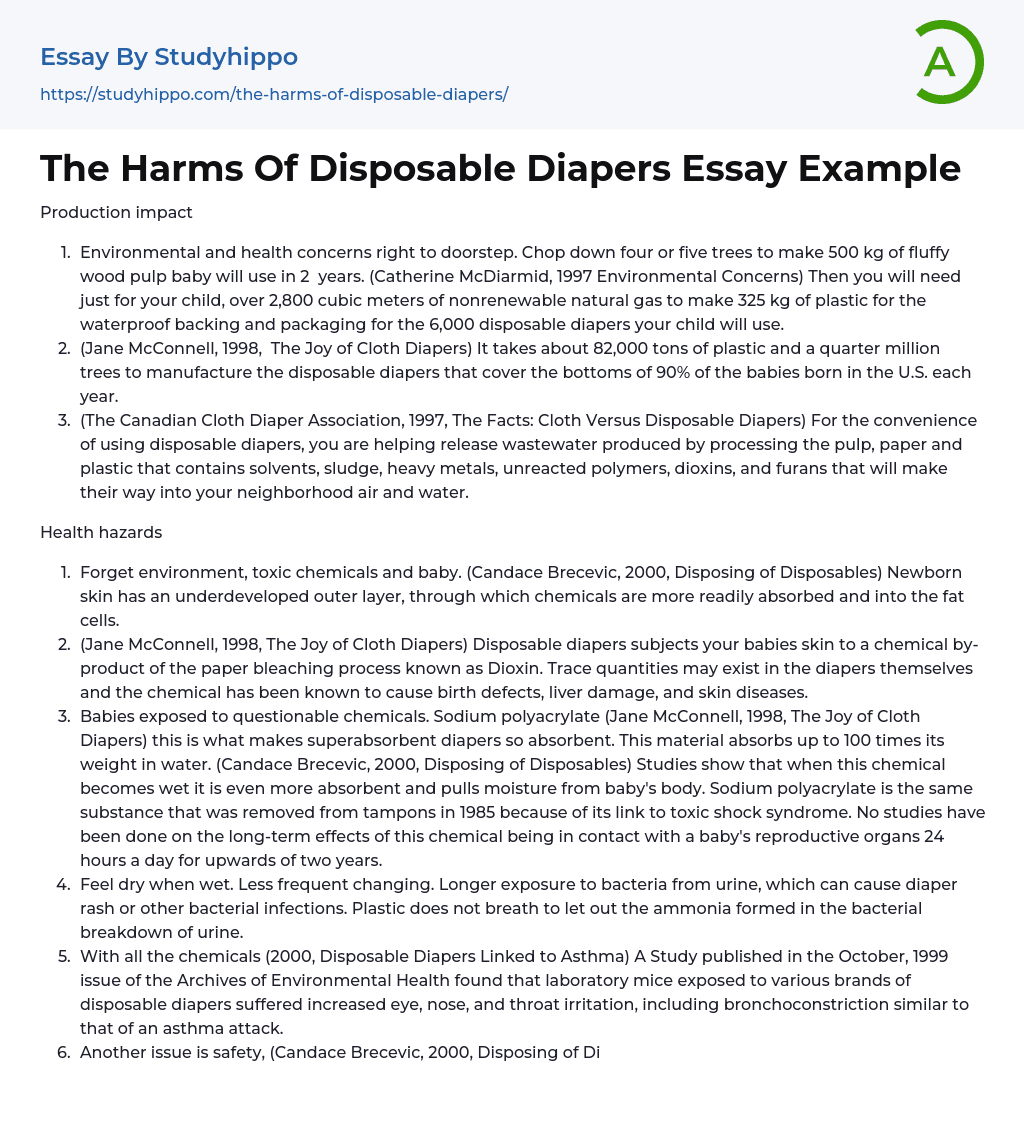Production impact
- Environmental and health concerns right to doorstep. Chop down four or five trees to make 500 kg of fluffy wood pulp baby will use in 2 years. (Catherine McDiarmid, 1997 Environmental Concerns) Then you will need just for your child, over 2,800 cubic meters of nonrenewable natural gas to make 325 kg of plastic for the waterproof backing and packaging for the 6,000 disposable diapers your child will use.
- (Jane McConnell, 1998, The Joy of Cloth Diapers) It takes about 82,000 tons of plastic and a quarter million trees to manufacture the disposable diapers that cover the bottoms of 90% of the babies born in the U.S. each year.
- (The Canadian Cloth Diaper Association, 1997, The Facts: Cloth Versus Disposable Diapers) For the convenience of using disposable diapers, you are helping release wastewater produced by processing the pulp,
...paper and plastic that contains solvents, sludge, heavy metals, unreacted polymers, dioxins, and furans that will make their way into your neighborhood air and water.
Health hazards
- Forget environment, toxic chemicals and baby. (Candace Brecevic, 2000, Disposing of Disposables) Newborn skin has an underdeveloped outer layer, through which chemicals are more readily absorbed and into the fat cells.
- (Jane McConnell, 1998, The Joy of Cloth Diapers) Disposable diapers subjects your babies skin to a chemical by-product of the paper bleaching process known as Dioxin. Trace quantities may exist in the diapers themselves and the chemical has been known to cause birth defects, liver damage, and skin diseases.
- Babies exposed to questionable chemicals. Sodium polyacrylate (Jane McConnell, 1998, The Joy of Cloth Diapers
View entire sampleJoin StudyHippo to see entire essay
this is what makes superabsorbent diapers so absorbent. This material absorbs up to 100 times its weight in water. (Candace Brecevic, 2000, Disposing of Disposables) Studies show that when this chemical becomes wet it is even more absorbent and pulls moisture from baby's body. Sodium polyacrylate is the same substance that was removed from tampons in 1985 because of its link to toxic shock syndrome. No studies have been done on the long-term effects of this chemical being in contact with a baby's reproductive organs 24 hours a day for upwards of two years.
if removed may be ingested.
Disposing of Disposables
- Exposing child to questionable chemicals, bacterial infection, and suffocation. Remove t soiled diaper, flushing the human waste, throw in trash ( Catherine McDiarmid, 1997,Environmental Concerns) you will be adding 214 pounds of raw fecal matter into our landfill sites which are not designed to handle human waste. As many as 100 viruses can survive in your babies soiled diaper for up to two weeks, including live polio viruses, excreted from your recently vaccinated baby. Rainwater washing through dumps can carry these viruses into underground streams and from there into our public and private water supplies.
- What happens to your child's 6,000 diapers? (Lee Reilly, 97, The Diaper Debate) When a diaper is thrown into a traditional trash system it is on its way to perpetual preservation. 6,000 per child (Jane McConnell 1998, The joy of Cloth Diapers) Disposable diapers make up the third largest source of preserved solid waste in landfills, after newspaper and food and beverage containers, a significant fact, considering they are a single product, used by a limited portion of the population. (Linda Baker, 1998, Bottom Out) Peter Spendelow, a waste reduction specialist at the Oregon Department of Environmental Quality says, Think about all the attention that is given to plastics and bottle recycling . Well there are now more dirty diapers in the landfills than rigid plastics combined. 18 billion diapers in landfills a year.
Conclusion
Clearly, there are problems related to using disposable diapers that can cause harm to the environment and to your family's health. Consider the unnecessary depletion of natural resources, the toxic air and water pollution
created in the manufacturing process, the health risk to your children and those drinking the water and the huge volume of garbage. It is very difficult to comprehend how washing and reusing cloth diapers could create equivalent damage.
Bibliography:
- Baker, Linda. Bottoming Out. E Magazine: The environmental Magazine. Sept/Oct, 1998
- Academic Search Elite. Galileo. 30, Oct. 2000.
- Brecevic, Candace. Disposing of Disposables. Natural Life. Sept/Oct, 2000.
- The Canadian Cloth Diaper Association. The Facts: Cloth versus Disposable Diapers. 18, April. 2000.
- Born to Love Diapering and Parenting Articles online. 30 Oct. 2000.
- Disposable Diapers Linked to Asthma. Mothering. Jan/Feb 2000.
- Health Source Plus.Galileo. 30 Oct. 2000.
- McConnell, Jane. The Joy of Cloth Diapers. Mothering. May/Jun. 1998.
- Reilly, Lee. The Diaper Debate. Vegetarian Times. Mar. 1997.
- Optical Fiber essays
- Freezing essays
- Polymer essays
- Bottled Water essays
- Animal Welfare essays
- Climate Change essays
- Conservation essays
- Global Warming essays
- Plastic essays
- Recycling essays
- Waste Management essays
- Zoo essays
- Automotive essays
- Automotive Industry essays
- Commerce essays
- Construction essays
- E Commerce essays
- Grocery stores essays
- Paper Industry essays
- Pharmaceutical industry essays
- Pharmacy essays
- Polymers essays
- Real Estate essays
- Textile Industry essays
- Accounting essays
- Andrew Carnegie essays
- Automation essays
- Business Cycle essays
- Business Intelligence essays
- Business Model essays
- Business Operations essays
- Business Software essays
- Cooperation essays
- Cooperative essays
- Corporate Social Responsibility essays
- Corporation essays
- Customer Relationship Management essays
- Family Business essays
- Franchising essays
- Harvard Business School essays
- Harvard university essays
- Human Resource Management essays
- Infrastructure essays
- Inventory essays
- Logistics essays
- Management essays
- Manufacturing essays
- Market essays
- Marketing essays
- Multinational Corporation essays




